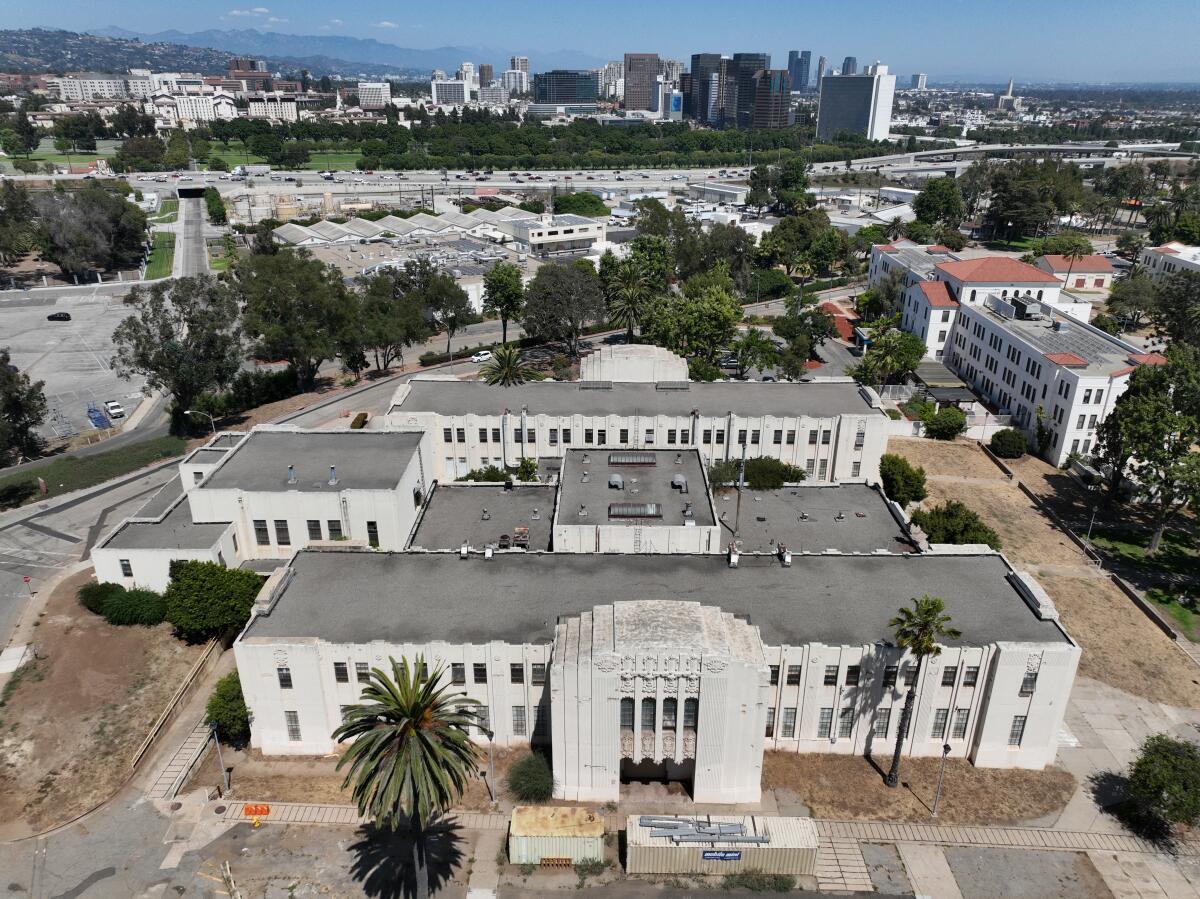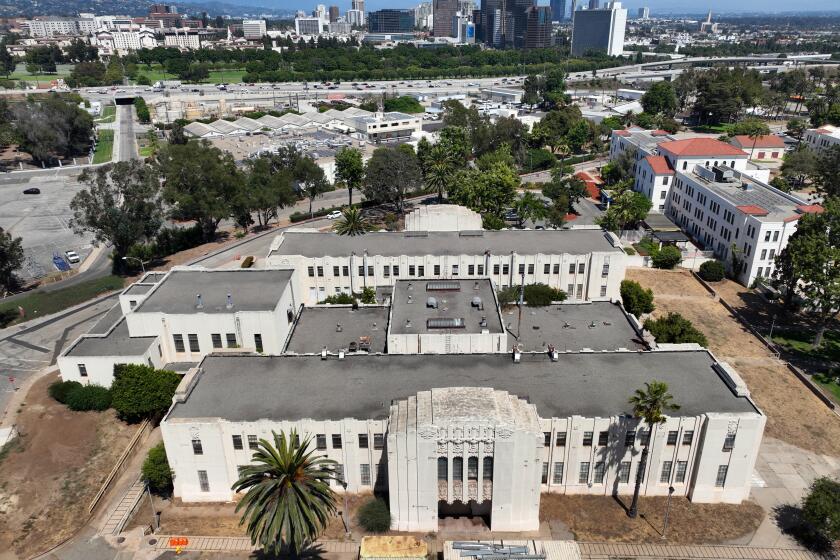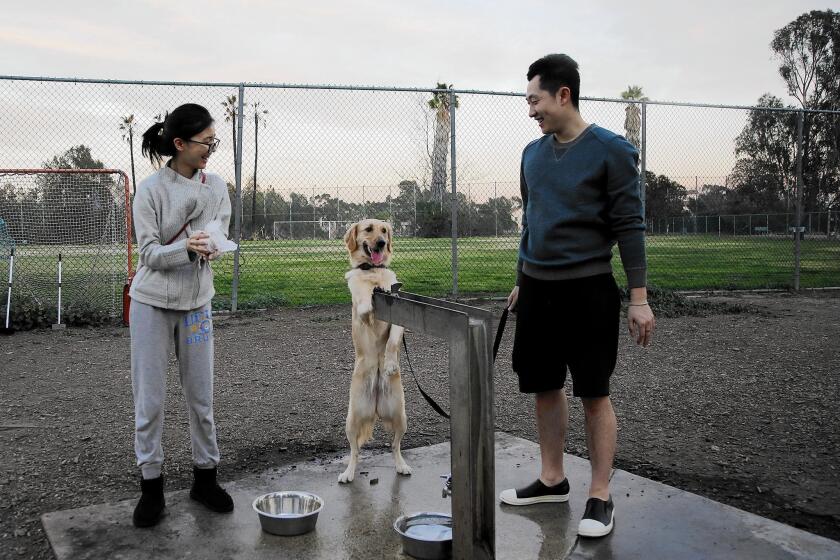Vets are pushing for a ‘Town Center’ on L.A.’s VA campus. But what is it? And will it have a hotel bar?

- Share via
- Developers for the VA see hundreds of units of supportive housing over ground-floor retail and service establishments.
- Many vets say the housing should go elsewhere on campus, and the center should be a consolidated retail and service district — with a hotel and bar to gather.
Building 13, at the center of the U.S. Department of Veterans Affairs’ West Los Angeles campus, is a century-old, two-story monolith composed of three wings adorned in intricate Art Deco detail.
It’s been vacant for decades, but it has a new destiny — if the money to restore it can be found — to anchor a town center at the heart of a community of veterans on the 388-acre campus.
For some veterans, its best use would be a veterans hotel — with a bar — a gathering place for veterans on the campus and their brothers and sisters around Southern California and the nation.
Bobby Shriver, the former Santa Monica mayor and veterans advocate who gathered ideas from focus groups he organized in 2015, said he was caught off guard but came to understand.
“It became clear to me that what they wanted was a hotel bar where they could go to meet other veterans from out of town.”
That vision may never become reality because a master plan for the property has a sharply different vision for Building 13.
It calls for a mixed-use facility with 24 units of supportive housing on the second floor for disabled and chronically homeless veterans and a culinary center and grand hall on the ground floor to make the building “a bustling center of activity,” though one lacking the social catalyst of a bar.
The differing visions for Building 13 are part of a larger tussle over construction plans that will shape the character of the veterans’ land for decades.
There is almost universal support for an — uppercase — Town Center as essential to serve a community that will one day have 3,000 or more veterans living on site in temporary and permanent housing and potentially thousands more visiting regularly from around Southern California.
But what is a Town Center?
- Share via
The developer contracted by the VA to build 1,200 units of new housing sees it as a Main Street radiating west of Building 13 and lined by four new buildings containing hundreds of units of supportive housing over ground floors occupied by veteran-owned businesses and services for veterans.
A veterans oversight board created to monitor the campus development vigorously disagrees. It opposes supportive housing in the Town Center and has advocated for uses that would serve veterans both living on the campus and attracted from far and wide, in particular a hotel.
“Nobody is advocating that VA not build housing,” said Anthony Allman, executive director of Vets Advocacy, a nonprofit created to monitor development of the VA grounds. “The immediate question at hand is where to locate that housing in relation to everything else that belongs on campus to make it a genuine community.”
Allman and other critics say the VA is killing the notion of a real town center because it can’t, or won’t, pay for it. Without money for a grand hall, fitness center or library, let alone a hotel, it is allowing its developer — which has access to capital for housing — to substitute housing where it isn’t needed, they say. The VA did not grant Times requests to interview officials about the Town Center.
U.S. District Judge David O. Carter castigated the VA for failing to use the 388-acre campus to ‘principally benefit veterans and their families.’
The West Los Angeles Veterans Collective, a partnership of housing developers and service providers selected in 2018 as the VA’s principal developer, can do everything the master plan calls for with philanthropic contributions and funds coming from a recent congressional authorization, said Brian D’Andrea, senior vice president of Century Housing.
“There are some in the community that want to turn this into the Grove at WLA,” D’Andrea said. “We do not think that is appropriate. We want our veterans on site to have access to convenient, affordable amenities and services. That is the spirit of what we’re proposing.”
He said Building 13 and the four new buildings that the veterans board opposes are critical to the Veterans Collective’s goal of completing 1,200 units of supportive housing. They would add about 400 housing units to the 800 either completed or planned farther north on the campus.
D’Andrea said the developers’ plans provide 90,000 square feet of space for community uses in the five buildings for amenities such as a town hall, workforce development center, coffee shop, barbershop, art studio, fitness facility, a business incubator, library or tech lab.
In a survey of veterans this spring in partnership the VA, the Veterans Collective did not hear any particular interest in a hotel, D’Andrea said.
As yet, it has not identified any business tenants for the Town Center. Nor has it produced a detailed plan for Building 13.
The dispute has been building for years in back-and-forth missives between successive VA secretaries and the Veterans and Community Oversight and Engagement Board, a 20-member body created by Congress to allow veterans a say in how their land was to be developed. It took a new turn this month when U.S. District Judge David O. Carter, after a four-week trial, included the Town Center in his order requiring the VA to build thousands of new shelter and housing units on the campus. He gave to the government 18 months to begin construction and appointed a monitor to ensure it happens.
Whether that gives the Veterans Collective a green light to proceed or opens the door to opponents to challenge its plan is yet to be determined. Carter is holding a hearing Wednesday to fill in the thorny details left out of his broad order.
The Town Center wasn’t initially part of the case that led to that order, but it emerged in testimony of several witnesses each offering a different interpretation of what it is.
Jonathan Sherin, former head of the Los Angeles County Department of Mental Health, said a veterans community should be a place where even those who are not living on the campus “can be with their brothers, their sisters, their military community family members, accessing community resources — whether it’s amenities, whether it’s entertainment, whether it’s recreation, whether it’s treatment.”
John Kuhn, deputy director of the VA’s West Los Angeles medical center, focused more on resident veterans.
Pet owners arrived at the Brentwood dog park one October morning to find that federal police had chained the gate shut.
“Certainly, housing veterans requires apartments, but all of us want to live in communities that are vibrant, that have active socialization, commercial activity, retail space, places that make it feel like a neighborhood, not just a place you go into to close the door,” Kuhn said.
Steve Soboroff, who oversaw the master-planned development of Playa Vista, said the VA Town Center needed its own master plan conducted by a specialist in community building rather than housing developers.
“I don’t believe that the infrastructure and the sense of community and the connective tissue can be done under the existing structure,” Soboroff said. “It takes a master plan developer. “
The Town Center was born from litigation that found the VA betrayed a trust to maintain land donated to the U.S. government in 1888 for the “establishment, construction and permanent maintenance” of a home for disabled soldiers.
Veterans contend that trust was broken when the VA removed about 1,000 men living on the campus in the aftermath of the 1971 Sylmar earthquake. The VA turned residential buildings into temporary medical facilities while the seismically vulnerable VA hospital was demolished and rebuilt. The home for disabled soldiers never reopened.
Meanwhile, the VA leased chunks of campus to outside institutions for athletic facilities, oil drilling and parking lots, setting the stage for more than a decade of litigation.
In 2011, veterans filed a lawsuit alleging that those leases were illegal and that the VA was failing its duty to provide housing for veterans. The VA reached a settlement in 2015 requiring it to develop a master plan for the campus.
A draft plan completed the following year envisioned a “downtown” for the 1,200 units of veteran housing to be built on the campus, a place where “veterans can socialize at a fitness center or cafe, participate in events in a public square, attend outdoor concerts, coordinate a volunteer effort, develop employment opportunities, visit a library, grab a bike to ride around the property or make plans for going to a movie at one of the campus theaters.”
It was in the course of gathering comments from veterans that Shriver, who raised philanthropic money to conduct the master plan, learned of the power of veterans’ common experience.
“If you talk to enough veterans, you’ll see that veteran energy is a real thing,” Shriver said. “Their thinking was, ‘If I could stay at the Hyatt or the Veterans Hotel, I’ll stay at the Veterans Hotel.’ It’s a good vibe, as the music people say.”
To ensure the veterans’ voices were heard, Shriver filed about 1,000 comments to the National Register.
“I think a hotel where veterans can have formal ceremonies like the annual Marine Corps birthday ball would be very important,” one of the veterans said. “The hotel can also house visiting dignitaries, celebrities, veterans, and be a great place to hold events. This hotel could be the crown jewel of the campus if done right as there could be events, conferences, and workshops held there every weekend.”
The VA, Shriver now says, didn’t listen.
Tension over the Town Center arose as members of the oversight board began to doubt the VA’s commitment.
In July 2018, the VA released a request for qualifications for a developer to implement the still-draft master plan. It specified that the developer would be responsible for financing the housing and could, “subject to feasibility and further negotiations,” assist the VA with other elements, “including town center.”
For Allman, at the time a member of the oversight board, the wishy-washy language spelled trouble, a suspicion confirmed for him when the Veterans Collective put out a news release on its selection as the principal developer that focused solely on housing with no mention of a town center.
Shriver and Allman now contend that VA simply set aside the 2016 draft master plan and instead deferred to the Veterans Collective to draw up its own plans.
The Veterans Collective published its vision in 2021. The North Campus Draft Community Plan, incorporated into the final 2022 master plan, acknowledged veterans’ desire for “a complete community, not just housing,” but acknowledged the “finite funding” available.
Urged by the oversight board to seek an outside opinion, VA Secretary Denis McDonough acquiesced and retained Urban Land Institute to field a panel of experts to make recommendations.
The institute’s report envisioned the town center as a semicircle of new buildings forming a quad with Building 13. In contrast to the developer’s east-west Main Street, it suggested a parade ground leading south to a new formal campus entrance incorporating the iconic Wadsworth Chapel.
The panel of experts also took issue with the plan to put veteran businesses on the first floor of supportive housing buildings, and not concentrate them in a more conventional business district. said Marty Borko, then executive director of ULI Los Angeles.
“They’re spreading it like peanut butter across the base of their buildings,” Borko said. “Our position was you needed to consolidate that to make it work.”
“We disagree with that,” said Stephen Peck, chief executive of U.S.Vets, the Veterans Collective partner that will renovate Building 13. “What they envision is a stand-alone town center where there is no residents. Once the sun goes down, all those buildings stand empty.”
In June, the oversight board unanimously asked the VA secretary to direct staff members to separate the Town Center from the master plan, not allow supportive housing in it, and issue a request for proposals to develop it.
Allowing supportive housing within the Town Center would “compromise both the privacy of the residences for our Veterans and the open and public gathering place feel for the overall community of Veterans for whom it serves,” the board said.
The West Los Angeles campus “should be woven into the cultural fabric of this city,” said Allman, who no longer sits on the board. “I’ve always viewed the Town Center concept as an exercise in shaping a positive veteran identity and, if executed correctly, an opportunity to bridge the military-civilian divide through conversation and commerce.”
More to Read
Sign up for Essential California
The most important California stories and recommendations in your inbox every morning.
You may occasionally receive promotional content from the Los Angeles Times.













